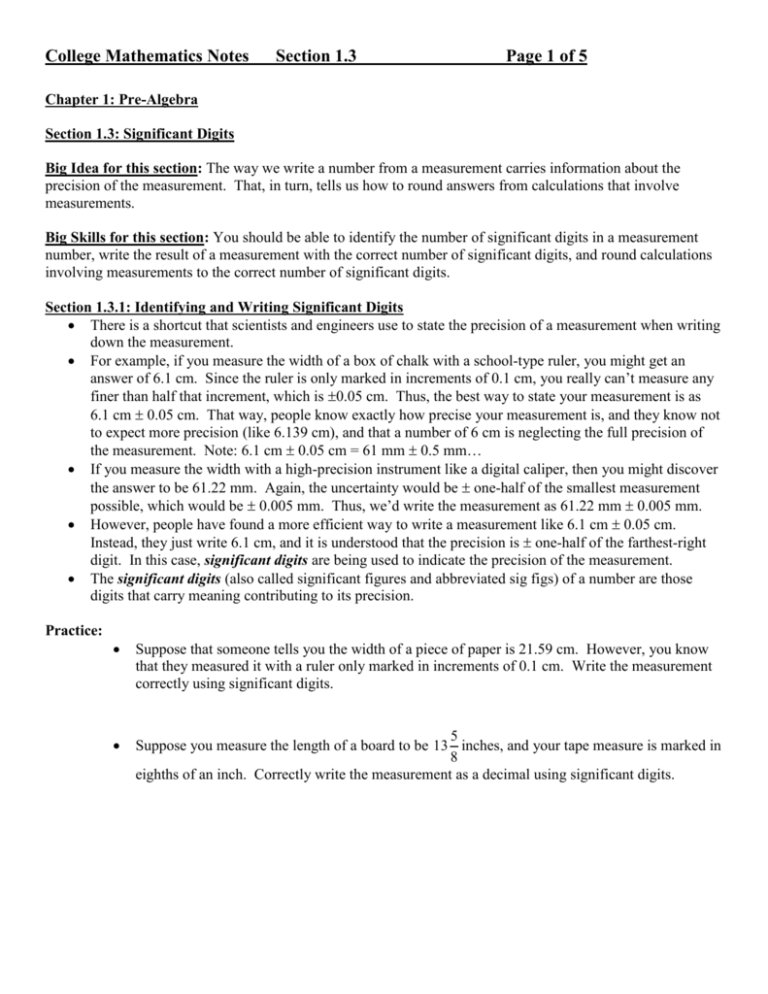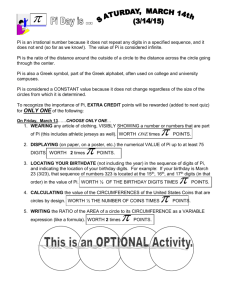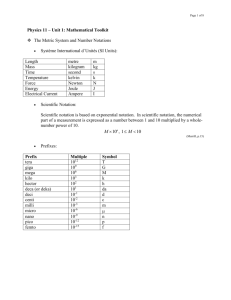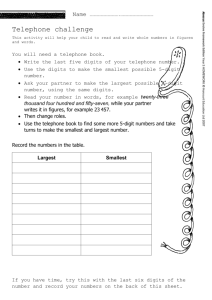Significant Digits - Madison Area Technical College
advertisement

College Mathematics Notes Section 1.3 Page 1 of 5 Chapter 1: Pre-Algebra Section 1.3: Significant Digits Big Idea for this section: The way we write a number from a measurement carries information about the precision of the measurement. That, in turn, tells us how to round answers from calculations that involve measurements. Big Skills for this section: You should be able to identify the number of significant digits in a measurement number, write the result of a measurement with the correct number of significant digits, and round calculations involving measurements to the correct number of significant digits. Section 1.3.1: Identifying and Writing Significant Digits There is a shortcut that scientists and engineers use to state the precision of a measurement when writing down the measurement. For example, if you measure the width of a box of chalk with a school-type ruler, you might get an answer of 6.1 cm. Since the ruler is only marked in increments of 0.1 cm, you really can’t measure any finer than half that increment, which is 0.05 cm. Thus, the best way to state your measurement is as 6.1 cm 0.05 cm. That way, people know exactly how precise your measurement is, and they know not to expect more precision (like 6.139 cm), and that a number of 6 cm is neglecting the full precision of the measurement. Note: 6.1 cm 0.05 cm = 61 mm 0.5 mm… If you measure the width with a high-precision instrument like a digital caliper, then you might discover the answer to be 61.22 mm. Again, the uncertainty would be one-half of the smallest measurement possible, which would be 0.005 mm. Thus, we’d write the measurement as 61.22 mm 0.005 mm. However, people have found a more efficient way to write a measurement like 6.1 cm 0.05 cm. Instead, they just write 6.1 cm, and it is understood that the precision is one-half of the farthest-right digit. In this case, significant digits are being used to indicate the precision of the measurement. The significant digits (also called significant figures and abbreviated sig figs) of a number are those digits that carry meaning contributing to its precision. Practice: Suppose that someone tells you the width of a piece of paper is 21.59 cm. However, you know that they measured it with a ruler only marked in increments of 0.1 cm. Write the measurement correctly using significant digits. 5 Suppose you measure the length of a board to be 13 inches, and your tape measure is marked in 8 eighths of an inch. Correctly write the measurement as a decimal using significant digits. College Mathematics Notes Section 1.3 Page 2 of 5 Suppose you measured the length of a race to be exactly 100 meters using a tape that measures to the nearest centimeter (i.e., hundredth of a meter). Write the measurement correctly using significant digits. What if the tape only measures to the nearest decimeter (i.e., tenth of a meter)? What if the tape only measures to the nearest meter? What if the finest increment of the tape is ten meters? What if the finest increment of the tape is 100 meters? That last practice problem embodies one of the most confusing parts of working with significant digits: measurements that have a lot of zeros in them. o When you want to show that a zero is significant, you go to the extra effort of writing extra stuff that you normally wouldn’t write, like putting extra zeros after the decimal point to show the finest increment of measurement: Example: 100.00 m o Continuing the theme of writing something a little extra to show what zeros are significant, an old-fashioned trick for showing which trailing zeros are significant is to put a bar over every significant zero: Like 100m or 100m for the last two examples above. o A more widely used trick to show when a measurement has been made to the nearest ones place is to put a decimal after the ones palce: 100 m 100. m The rule for identifying the significant digits in a measurement can be stated in two ways: o All digits are significant except leading zeros after a decimal point and trailing zeros before it. Both types of zeros merely serve as placeholders. o “point right, otherwise left”: If there is a decimal point present, find the left-most nonzero digit, and then count digits toward the right. If there is no decimal point in the number, find the right-most nonzero digit and count toward the left. In both cases, keep counting digits until you reach the other end of the number. College Mathematics Notes Section 1.3 Page 3 of 5 Practice: State the number of significant digits in each measurement below 467.24 ft. 0.006020 m 1250 lb. 0.00003 g 93,000,000 mi 800 in. 800. in. 1250. lb. Section 1.3.2: Significant Digits after Adding or Subtracting When you add or subtract measurements, then you have to round your answer to the precision of the least accurate measurement. That’s because the uncertainty in the least precise measurement overwhelms the precision of the other measurements. 28.25 cm +15.67 cm Practice: 114.37 cm 3.080 cm +27.3 cm 22.85 g – 13.35 g = 13 ft – 5.811 ft = 1250.27 mi + 3367.7 mi + 2257 mi + 4800 mi = College Mathematics Notes Section 1.3 Page 4 of 5 Section 1.3.3: Significant Digits after Multiplying or Dividing Rule: Find the measurement with the fewest significant figures. Round your answer to that many significant figures. The rule has to do with how the uncertainties can combine in the final answer: Example: if the floor of a room is measured at 14.12 feet long and 9.8 feet wide, our calculators would give us an area of Area = 14.12 ft. 4.8 ft. = 67.776 sq. ft. However, 14.12 ft. 14.12 ft. 0.005 ft. the length could range from 14.115 ft. to 14.125 ft. Also, 4.8 ft. 4.8 ft. 0.05 ft. the width could range from 4.75 ft. to 4.85 ft. So, the largest possible area under these uncertainties would be 14.125 ft. 4.85 ft. = 68.50625 sq. ft. The smallest possible area under these uncertainties would be 14.115 ft. 4.75 ft. = 67.04625 sq. ft. The average of those two areas is 67.77625 sq. ft., which is 0.73 sq. ft. from either extreme. Thinking of uncertainty as one-half of a finest increment of measurement, we would round the uncertainty to 0.5 sq. ft., so we would have to round the answer to 68 sq. ft. to reflect this uncertainty. Or, we could have used the rule; the measurement of 4.8 ft. has the least number of significant digits (two sig. figs.), so the final answer can only have two significant digits. A good way to show the work is: Area = 14.12 ft. 4.8 ft. = 67.776 sq. ft. 68 sq. ft. One exception to the rule: numbers without a unit of measurement attached are considered exact numbers that have an infinite number of significant digits. Ignore them when determining the number of sig. figs. in your answer. Example: 100 22.85 cm = 2285 cm Practice: 1) 2.54 in. 3 in. = 2) 310.2 cm x 51.05 cm x 0.100 cm = 3) 22.85 ft2 / 4 ft. = 4) 358.9 m3 / 22 m2 = 5) 75.40 g / 7.1 mL = College Mathematics Notes 6) 52.5 mi/hr 3.8752 hr = Section 1.3 Page 5 of 5








